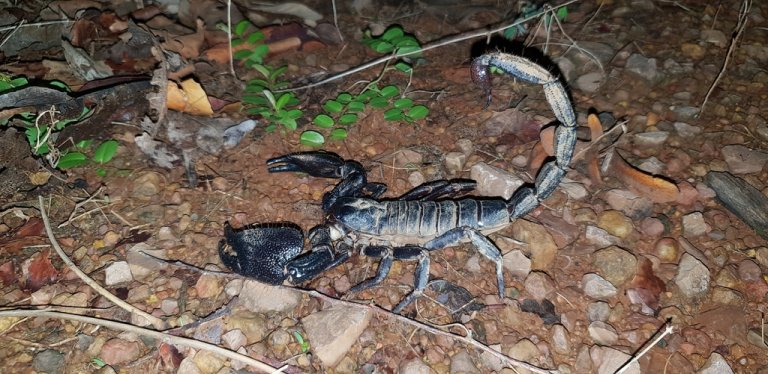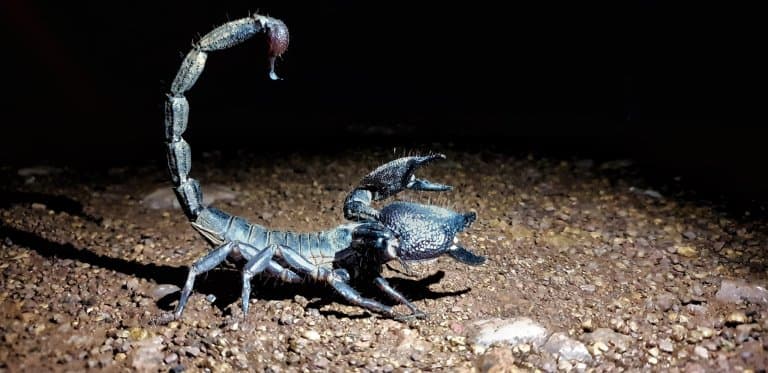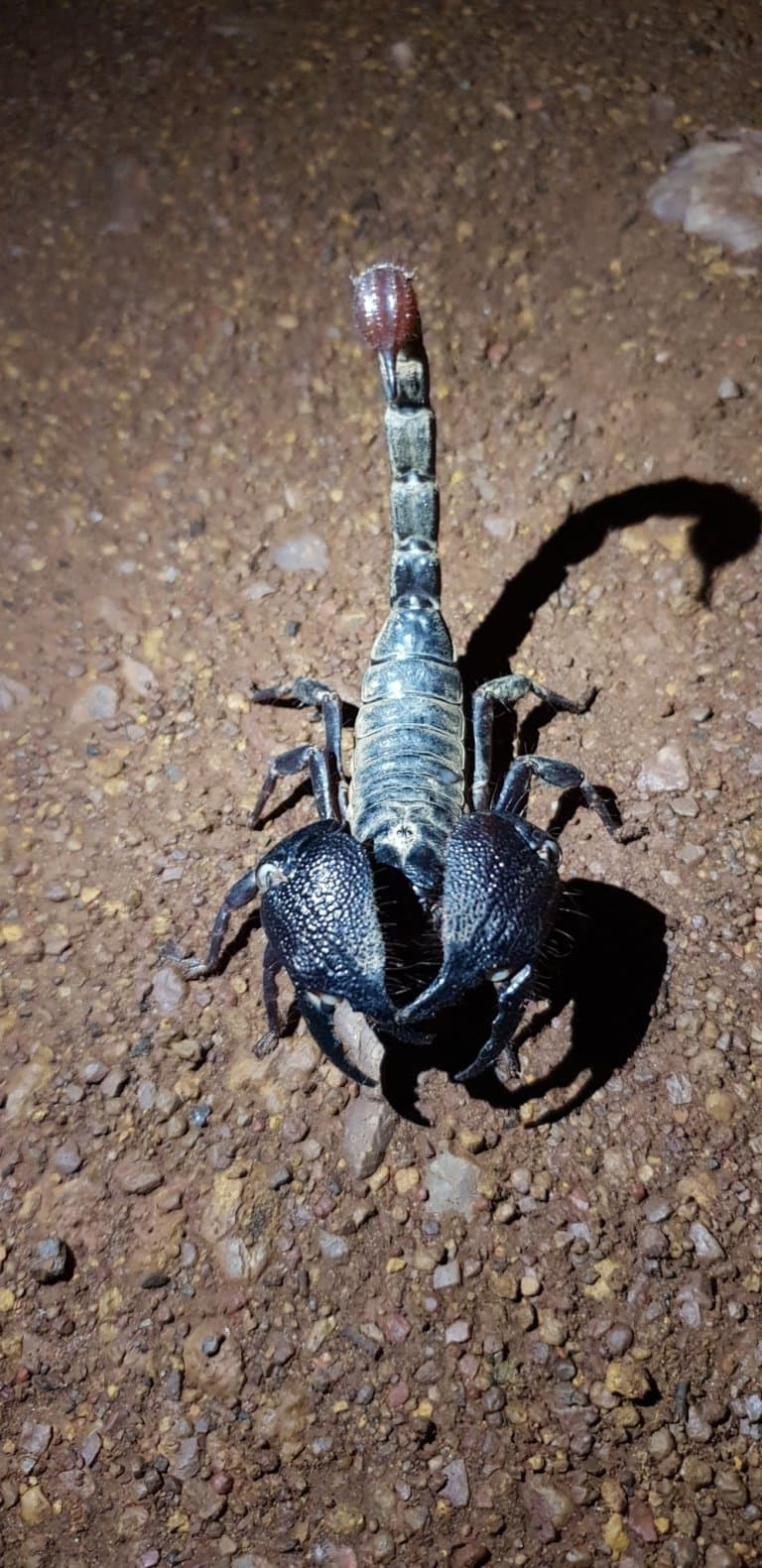Giant Forest Scorpion Profile
Have you ever seen the largest scorpion in the entire world? Look no further than Gigantometrus swammerdami, the giant forest scorpion.
These supersized scorpions are native to India, where they eat a wide variety of prey. They’re solitary animals, and they can be found day or night (although the latter is more common). In India, they’re most common in the warmer climates, such as the rainforests of the country.

Giant Forest Scorpion Facts Overview
| Habitat: | Rainforests |
| Location: | India and Sri Lanka |
| Lifespan: | 7-8 years |
| Size: | Up to 23 cms (9 inches) |
| Weight: | Up to 56 grams |
| Color: | Reddish brown to reddish black |
| Diet: | Insects, spiders, and other scorpions |
| Predators: | Birds of prey, mammals, and certain reptiles like lizards |
| Top Speed: | 15 kph (10 mph) |
| No. of Species: |
1 |
| Conservation Status: |
Least concern |
The giant forest scorpion is reddish brown-black in color, while juveniles tend to have a tinge of yellow. They have huge, powerful pincers, which they use to hunt insects and other invertebrates on the forest floor amongst the leaf litter.
Like all scorpions, they have a hard exoskeleton, which they moult as they grow. They will wriggle out of their old skin, and their new exoskeleton will harden for protection.
The giant forest scorpion like other species of scorpion will give live birth and the female looks after her young, by transporting them on her back until they grow and their exoskeleton hardens.
To learn more about just how unbelievable the giant forest scorpion is, keep reading.
Interesting Giant Forest Scorpion Facts
1. The giant forest scorpion is the largest species of scorpion
Gigantometrus swammerdami is the largest species of scorpion in the entire world! The largest of this species can grow to be up 23 centimeters long. That’s almost the same size as a bowling pin!
Not only that, but the giant forest scorpion can always weigh as much as nearly 60 grams. Although that may not seem like a lot, it’s around the same weight as a tennis ball, which is heavier than any other scorpion in the world, too. 1
2. It doesn’t rely on venom to hunt prey
It’s important to note that, like all other species of scorpions, the giant forest scorpion is a venomous species.
However, while they do have this venom to use as necessary, it’s not actually the primary way that they’re able to hunt down their impressive prey.
Instead, similar to a constrictor type of snake, scorpions crush their prey with their powerful pinchers!
3. They’re related to spiders
Although the scientific name is Gigantometrus swammerdami, this only reveals a little bit of information about the giant forest scorpion. Specifically, this displays their genus and species.
However, when you only look at this information, it can be easy to miss some of the amazing ways different animals are connected!
For instance, did you know that scorpions are actually related to spiders?
That’s right, both spiders and scorpions are in the class Arachnida. This also includes some other surprising species such as ticks and mites.
4. Giant forest scorpion refers to two different species
The giant forest scorpion is a great example of why scientific names are important. There are actually two species that are known as the giant forest scorpion. The first is Gigantometrus swammerdami, which is the species you’re reading about right now.
The other species known by this common name is Heterometrus spinifer. Other common names for H. spinifer include Asian forest scorpion, and giant blue scorpion.
As you can tell from their different genera, which is the first word in their scientific name, these two species aren’t closely related compared to other, more similar species of scorpion.
However, they do have similar appearances, and they both are located in the southern regions of Asia.
As a result, it’s important to be able to tell these species apart, which is where the significance of having scientific names can come in. 2
5. They are solitary animals
Outside of mating season, giant forest scorpions are solitary animals. This means that they’ll spend their time alone, whether they are resting or hunting.
The mating season for the Gigantometrus swammerdami is in the summer months. During this time, the more recluse individuals will leave their burrows and come together. Some species of scorpions have a mating dance, while others may sting and even cannibalize one another.
What’s most surprising about the scorpion is that they have live births, like mammals! They’re what is known as ovoviviparous, which means the eggs hatch inside the mother prior to birth.

6. They can be found inside other animals’ homes
When it comes to locating their next giant forest scorpion, scientists have figured out exactly where to look. As it turns out, giant forest scorpions like to live in the abandoned burrows of other animals.
Scientists have found them in notches in trees, degrading termite mounds, and even in old rat burrows or crab holes!
7. They have comb-like teeth called pectines
The giant forest scorpion has anywhere from 16 to 20 little comb-like teeth known as pectines.
Typically, pectinal teeth are used for grooming. However, they may also be used for other advantages in the natural world, from filtering to helping sense an animal’s environment.
This is what many scorpions use their pectines for: sensory. Their teeth are built in a way to detect and translate chemical and physical stimuli to the brain, helping them to better understand their environment.

8. We have a good understanding of their venom
Although there isn’t a lot known about the Gigantometrus swammerdami, we do have a good understanding of their venom. It’s a mild paralytic in small species.
However, since they’ve evolved to rely on their pinchers for hunting, their venom isn’t lethal to most humans.
Giant Forest Scorpion Fact-File Summary
Scientific Classification
| Kingdom: | Animalia |
| Phylum: | Arthropoda |
| Class: | Arachnida |
| Order: | Scorpiones |
| Family: | Scorpionidae |
| Genus: | Gigantometrus |
| Species Name: |
Gigantometrus Swammerdami |
Fact Sources & References
- Kendall L Hughes, Douglas D Gaffin (2019), “Investigating sensory processing in the pectines of the striped bark scorpion, Centruroides vittatus“, National Library of Medicine.
- Bagari Ramakrishna (2021), “Diversity and distribution of Asian forest scorpions (Arthropoda, Scorpionidae, Heterometrinae) in Telangana State, India“, Osmania University, College of Science, Department of Zoology.
